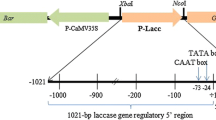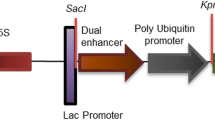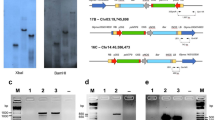Abstract
A gene encoding the preproprotein of the pea (Pisum sativum) lectin was expressed in transgenic potato plants using a cauliflower mosaic virus (CaMV) 35S promoter or a tobacco ribulose bisphosphate carboxylase small subunit (ssRubisco) promoter. Presence of the pea lectin to levels greater than 1% of total soluble leaf protein was detected by radioimmunoassay (RIA). The pattern of expression derived from the two promoters was established using both RIA and a squash-blot immunolocalisation technique. Western blotting demonstrated that the preproprotein was correctly processed, generating α and β subunits that assembled to give an isolectin form observed in pea seeds and roots. It was also found that the haemagglutination activity and specificity of pea lectin synthesised in transgenic potato leaves was comparable to purified lectin from pea cotyledons.
Similar content being viewed by others
References
Allen AK, Neuberger A: Potato lectins. In: Ginsberg V (ed), Methods in Enzymology, vol 50, pp. 340–345. Academic Press, New York (1978).
Beachy RN, Cheu ZL, Horsch RB, Rogers SG, Hoffmann NJ, Fraley RT: Accumulation and assembly of soybean β-conglycinin in seeds of transformed petunia plants. EMBO J 4: 3047–3053 (1985).
Begbie R, King TP: The interaction of dietary lectin with porcine small intestine and the production of lectin specific antibodies. In: Bog-Hansen TC, Boboritch J (eds) Lectins: Biology, Biochemistry, Clinical Biochemistry, vol 5, pp. 15–27. Walter de Gruyter, Berlin (1985).
Bevan M: BinaryAgrobacterium vectors for plant transformation. Nucl Acids Res 12: 8711–21 (1984).
Boulter D. In: Magnien E (ed) Final report in Biomolecular Engineering in the European Community: Achievements in the Research Programme (1982–1986), pp. 715–725. Martinus Nijhoff, The Hague (1986).
Boulter D, Edwards GA, Gatehouse AMR, Gatehouse JA, Hilder VA: Additive protective effects of different plant-derived insect resistance genes in transgenic tobacco plants. Crop Prot 9: 351–354 (1990).
Bradford M: A rapid and sensitive method for the quantitation of microgram quantities of protein using the principle of dye-binding. Analyt Biochem 72: 248–254 (1976).
Czernilofsky AP, Hain R, Herrera-Estrella L, Lorz H, Goyvaerts E, Baker BJ, Schell J: Fate of selectable marker DNA integrated into the genome ofNicotiana tabacum. DNA 5: 101–113 (1986).
Dellaporta SL, Wood J, Hicks JB: A plant DNA mini preparation: version II. Plant Mol Biol Rep 1: 19–21 (1993).
Diaz CL, Hosselet M, Logman GJJ, van Driessche E, Lugtenberg BJ, Kijne JW: Distribution of glucose/mannose-specific isolectins in pea (Pisum sativum L.) seedlings. Planta 181: 451–461 (1990).
Diaz CL, Melchers LS, Hooykaas PJJ, Lugtenberg BJJ, Kijne JW: Root lectin as a determinant of host-plant specificity in theRhizobium-legume symbiosis. Nature 338: 579–581 (1989).
Diaz CL, van Spronsen PC, Bakhuisen R, Logman GL, Lugtenberg EJ, Kijne JW: Correlation between infection ofRhizobium leguminosarum and lectin on the surface ofPisum sativum L. roots. Planta 168: 350–359 (1986).
Edwards GA: Plant transformation using anAgrobacterium tumefaciens Ti-plasmid vector system. Ph.D. Thesis, University of Durham, UK (1988).
Ellis JR, Shirsat AH, Hepher A, Yarwood JN, Gatehouse JA, Croy RRD, Boulter D: Tissue-specific expression of a pea legumin gene in seeds ofNicotiana plumbaginifolia. Plant Mol Biol 10: 203–214 (1988).
Etzler ME. Plant lectins: molecular and biological aspects. Ann Rev Plant Physiol 36: 209–234 (1985).
Gatehouse JA, Brown D, Evans IM, Gatehouse LN, Jobes D, Preston P, Croy RRD: Sequence of the seed lectin gene from pea (Pisum sativum L.). Nucl Acids Res 15: 7642 (1987).
Gatehouse JA, Boulter D: Isolation and properties of a lectin from the roots ofPisum sativum (garden pea). Physiol Plant 49: 437–442 (1980).
Gatehouse JA, Evans IM, Croy RRD, Boulter D: Differential expression of seed genes during legume seed development. Phil Trans R Soc Lond B 314: 341–500 (1986).
Goldsbrough PB, Gelvin SB, Larkins BA: Expression of maize zien genes in transformed sunflower cells. Mol Gen Genet 202: 374–381 (1986).
Grant G: Antinutritional effects of dietary lectins. Aspects Appl Biol 19: 51–74 (1989).
Hall TC, Buchbinder BV, Pyne JW, Sun SM, Bliss FM: Messenger RNA for G1 protein of french bean seeds: cell-free translation and product characterisation. Proc Natl Acad Sci USA 75: 3196–3200 (1978).
Higgins TJV, Chandler PM, Zurawaski G, Button SC, Spencer D: The synthesis and primary structure of pea seed lectin. J Biol Chem 258: 9544–9549 (1983).
Higgins TJV, Chrispeels MJ, Chandler PM, Spencer D: Intracellular sites of synthesis and processing of lectin in pea cotyledons. J Biol Chem 258: 9550–9552 (1983).
Jacobsen E, Templelaar MJ, Bijmout EW: Ploidy levels in leaf callus and regenerated plants ofSolanum tuberosum determined by cytophotometric measurements of protoplasts. Theor Appl Genet 65: 113–118 (1983).
Jahn R, Schiebler W, Greengard P: A quantitative dotimmunobinding assay for proteins using nitrocellulose. Proc Natl Acad Sci USA 81: 1684–1687 (1984).
Johnson DA, Gautsch JW, Sportsman JR, Elder JH: Improved technique utilizing nonfat dry milk for analysis of proteins and nucleic acids transfered to nitrocellulose. Gene Anal Tech 1: 3–8 (1984).
Kijne JW, Van der Schaal IAM, Diaz CL, Van Iren F: Mannose specific lectins and the recognition of pea roots byRhizobium leguminosarum. In: Bog-Hansen TC, Spengler GA (eds) Lectins: Biology, Biochemistry, Clinical Biochemistry, vol 3, pp. 521–529. Walter de Gruyter, Berlin (1983).
Kyhse-Anderson J: Electroblotting of multiple gels: a simple apparatus without buffer tank for rapid transfer of proteins from polyacrylamide to nitrocellulose. J Biochem Biophys Meth 10: 203–209 (1984).
Lawton MA, Tierney MA, Nakamura I, Anderson E, Komeda Y, Dube P, Hoffman N, Fraley RT, Beachy RN: Expression of a soybean β-conglycinin gene under the control of the cauliflower mosaic virus 35S and 19S promoters in transformed petunia tissues. Plant Mol Biol 9: 315–324 (1987).
Lis H, Sharon N: Lectins as molecules and tools. Ann Rev Biochem 55: 35–68 (1986).
Maniatis T, Fritsch EF, Sambrook J: Molecular Cloning: A Laboratory Manual. Cold Spring Harbor Laboratory, Cold Spring Harbor, NY (1982).
McMarsters GK, Carmichael GG: Analysis of single- and double-stranded nucleic acids on polyacrylamide and agarose gels by using glyoxal and acridine orange. Proc Natl Acad Sci USA 74: 4835–4838 (1977).
Moreno J, Chrispeels MJ: A lectin gene encodes the a-amylase inhibitor of the common bean. Proc Natl Acad Sci USA 86: 7885–7889 (1989).
Okamuro JK, Jofuku KD, Goldberg RB: Soybean seed lectin gene and flanking nonseed protein genes are developmentally regulated in transformed tobacco plants. Proc Natl Acad Sci USA 83: 8240–8244 (1986).
Osborn TC, Alexander DC, Sun SSM, Cardona C, Bliss FA: Insecticidal activity and lectin homology of arcelin seed protein. Science 240: 207–210 (1989).
Prasthofer T, Phillips SR, Suddath FL, Engler JA: Design, expression and crystallization of recombinant lectin from the garden pea (Pisum sativum). J Biol Chem 264: 6793–6796 (1989).
Pratt RC, Singh NK, Shade RE, Murdock LL, Bressan RA: Isolation and partial characterisation of a seed lectin from tepary bean that delays bruchid beetle development Plant Physiol 93: 1453–1459 (1990).
Rini JM, Hofmann T, Carver JP: Amino acid sequence differences in the alpha chains of pea seed isolectins: C-terminal processing. Biochem Cell Biol 65: 338–344 (1987).
Rosahl S, Schell J, Willmitzer L: Expression of a tuberspecific storage protein in transgenic potato plants: demonstration of an esterase activity. EMBO J 6: 1155–1159 (1987).
Sengupta-Gopalan C, Reichert NA, Barker RF, Hall TC: Developmentally regulated expression of the bean β phaseolin gene in tobacco seed. Proc Natl Acad Sci USA 82: 3220–3324 (1985).
Shagger H, Von Jagow G: Tricine-sodium dodecyl sulfate-polyacrylamide gel electrophoresis for the separation of proteins in the range of 1 to 100 kDa. Analyt Biochem 166: 368–379 (1987).
Sharon N, Lis H: Lectins: cell-agglutinating and sugarspecific proteins. Science 177: 949–959 (1972).
Sonnewald U, Sturm A, Chrispeels MJ, Willmitzer L: Targetting and glycosylation of patatin, the major potato tuber protein in leaves of transgenic tobacco. Planta 179: 171–180 (1989).
Sturm A, Voelker TA, Herman EM, Chrispeels MJ: Correct glycosylation, golgi-processing and targeting to protein bodies of the vacuolar protein phytohemaglutinin in transgenic tobacco. Planta 175: 170–183 (1988).
Thomas PS: Hybridization of denatured RNA and DNA fragments transfered to nitrocellulose. Proc Natl Acad Sci USA 77: 5201–5205 (1980).
Trowbridge IS: Isolation and characterization of a mitogenic lectin fromPisum sativum. J Biol Chem 249: 6004–6012 (1974).
Voelker TA, Herman EM, Chrispeels MJ: In vitro mutated phytohemagglutinin genes expressed in tobacco seeds: Role of glycans in protein targetting and protein stability. Plant Cell 1: 95–104 (1989).
Wilkins TA, Bednarek SY, Raikhel NV: Role of propeptide glycan in post-translational processing and transport of barley lectin to vacuoles in transgenic tobacco. Plant Cell 2: 301–313 (1990).
Zambryski P, Joos H, Genetello C, Leemans J, Van Montagu M, Schell J: Ti plasmid vector for the introduction of DNA into plant cells without alteration of their normal regeneration capacity. EMBO J 2: 2143–2150 (1983).
Author information
Authors and Affiliations
Rights and permissions
About this article
Cite this article
Edwards, G.A., Hepher, A., Clerk, S.P. et al. Pea lectin is correctly processed, stable and active in leaves of transgenic potato plants. Plant Mol Biol 17, 89–100 (1991). https://doi.org/10.1007/BF00036809
Received:
Accepted:
Issue Date:
DOI: https://doi.org/10.1007/BF00036809




